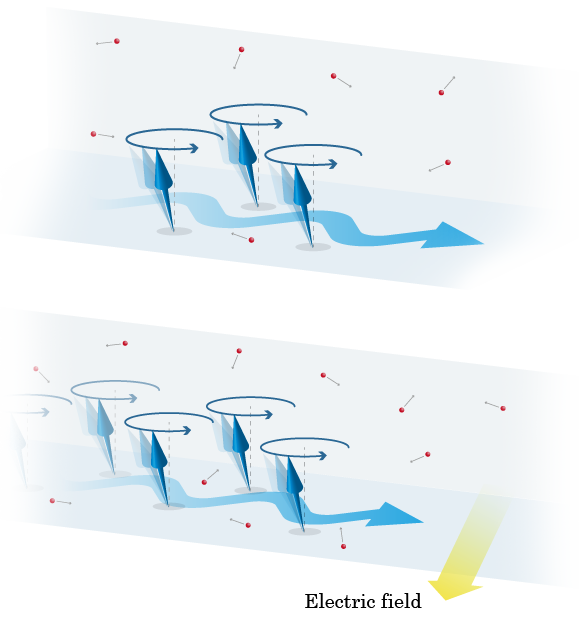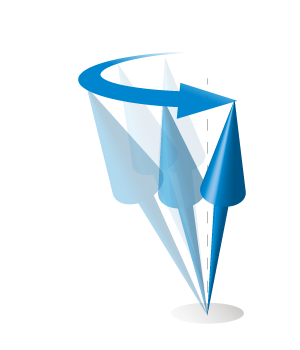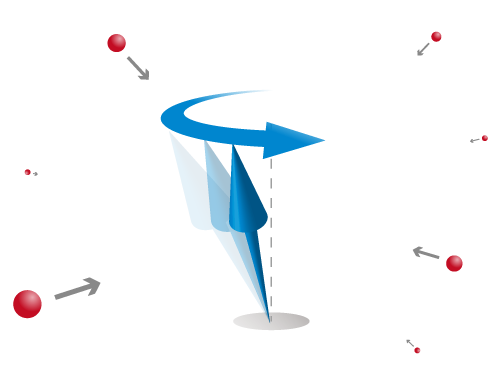Introduction
ERATO Saitoh Spin Quantum Rectification Project is a Japanese government funded academic research program. We are challenging to explore the new horizon of spin science focusing on proving the new use of spin for the purpose of energy harvesting from various energy fluctuations which so far are just wasted energy. In this page, we present the brief history of our research endeavour and challenge of this research program.
What is Spin?
Spin is the internal angular momentum of electron. This mysterious rotation of elementary particle is the natural conclusion of relativistic quantum mechanical theory established in 1928 by Paul Adrian Maurice Dirac. According to his theory, an electron has ? spin and it can have two discrete states: up spin and down spin. This tiny but persistent angular momentum plays essential roles in condensed matters to realize various phenomenon such as magnetism and superconductivity, and is the centre of research subject for nearly a century in both views of academic interests and industrial applications.
Advent of Spin Current
The recent highlight of spin science is the advent of spintronics. In the context of spintronics, spin is utilized as the carrier of information based on its two discrete states as a bit. The motive of spintronics is to substitute for the existing electronics technologies as much more energy efficient one in order to overcome the limit of Moore’s law. Why are the spintronics devices so energy efficient? The answer is “spin current”. Since electronics uses the charge of electrons as the carrier of information, there is always Joule heating when the information transmit as the flow of electron charges. On the other hand, since spintronics uses the spin angular momentum, there is no Joule heating when the spin flows to carry the information. Thus, the flow of spin angular momentum, a spin current, is the key of spintronics advantage and has become the Prima of spin science.
Discovery of the law of spin-current
When the idea of spin current came up, there is no theory for this weird flow. Actually, when we look at Maxwell Equations, the natural law of electromagnetism, there are no hints of spin current. Thus, the team lead by Professor Saitoh started to explore the hidden law of spin current.
Their pioneering works experimentally revealed the laws of spin current exactly corresponding to those of charge current. They are known as “Spin Pumping”, corresponding to Faraday’s law, and “Inverse Spin Hall Effect”, corresponding to Ampere’s law. Establishments of these laws for spin current suggest that precession of spin generates the spin current and the flaw of spin current generates workable electric voltages.

Spin cannot reverse
The exploring of the laws of spin current found another surprising discovery: Spin Seebeck Effect. This phenomena shows that even thermally activated random momentum can excite the precession of spin to generate the spin current and generate workable electric voltages. Why can such a surprising energy harvesting be possible? The hidden mechanism is originated from the inherent property of spin: “the violation of time reversal symmetry”. In other words, spin is allowed to rotate only in the anti-clockwise direction. Because of this property, even random momentum can activate the unidirectional spin precession under well-engineered thermal conditions.

From Spintronics to Spin Rectification
Now that we know the inherent property of spin and the mechanism to generate workable energy from fluctuations, it’s time to expand our research to the stage of proof of concepts of spin based energy harvesting in various systems. We call this new horizon of spin science as “Spin Quantum Rectification”. We are pleased to announce the launch of this new endeavour with the support of Japanese government. This research project is funded by Exploratory Research for Advanced Technology (ERATO) program.

view about facilities